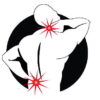What Is Kinesiology?
A Valuable Tool for Balancing Structure
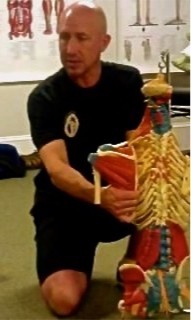
When asking What Is Kinesiology, it can refer to a very specific Science of Posture, Movement & Action. Or it is sometimes called Biomechanics. OR, it can be an entire health or medical profession unto itself with a very wide range of elements. …
Let’s explore that a bit …
But First, we are NOT here talking about what is commonly called “Applied Kinesiology.” That is a specialized and even esoteric and (in many cases) somewhat paranormal (even supernatural) method of using muscle strength to test for problems such as metabolic, nutritional, or dietary issues.
Applied Kinesiology, in general (there are many variations), says there is a “biocomputer” in every Client’s body that can tell the therapist much of what is going on in that body, and sometimes mind too. It is very often used to diagnose and/or treat various, wide-ranging health & medical issues. …
There is a lot of controversy about its validity and accuracy, but that is outside the scope of this discussion.
Regardless, such therapists are NOT in such cases using kinesiology to DIRECTLY analyze or evaluate movement or posture as we at the Schools of Advanced Bodywork use it. Although they could be taking those elements into consideration, depending on the Client’s complaints or objectives.
Yet that approach to kinesiology is a completely different study and outside the scope of what is taught at the SABs (Schools of Advanced Bodywork.)
The SABs provide a unique approach to kinesiology not found in most massage or bodywork schools. It is central to figuring out how to de-compress, re-balance, & restore to better health a Client’s body.
So, referring to a less esoteric meaning of the question of What Is Kinesiology …
Wikipedia defines Kinesiology as …
Kinesiology (from Ancient Greek κίνησις (kínēsis) ‘movement’, and -λογία -logía ‘study of’) is the scientific study of human body movement. Kinesiology addresses physiological, anatomical, biomechanical, pathological, neuropsychological principles and mechanisms of movement.
Applications of kinesiology to human health include biomechanics and orthopedics; strength and conditioning; sport psychology; motor control; skill acquisition and motor learning; methods of rehabilitation, such as physical and occupational therapy; and sport and exercise physiology.
Studies of human and animal motion include measures from motion tracking systems, electrophysiology of muscle and brain activity, various methods for monitoring physiological function, and other behavioral and cognitive research techniques.
And as stated in Wikipedia, the word kinesiology itself stems from the Greek word for kinesis, or movement. There can be a lot of potential elements to it, including biomechanics and physics. There are even degrees, some of them requiring years to graduate.
Yet for our purposes, it all revolves around the question of how a person stands, moves, and takes action.
SO, for Our Purposes of Massage & Bodywork …
What IS Kinesiology?
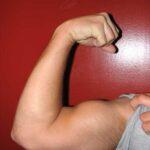
FIG. #1
IMAGE from https://www.wikidoc.org/index.php/Biceps_brachii_muscle
Kinesiology, in brief, is the Science of Movement & Action of the body. …
A more specific idea is that kinesiology is the study of how and where bones move when various muscles pull on them. …
So in simple kinesiology, for example, when the biceps brachii (in the front of the upper arm) contracts, the forearm is pulled toward the upper arm, bending at the elbow joint. … And the bicep, like most muscles, bulges as it contracts as well.
So the biceps brachii acts upon — bending or flexing — the elbow joint. And the more muscle fibers engaged in the action the more strength is generated.
The below illustration of bicep brachii and brachioradialis action is from the website of BCCampus (British Columbia/Yukon Open Authoring Platform). Notice that they use the term “Biomechanics” instead of kinesiology in their online textbook. This is not incorrect, as kinesiology is a wide-ranging topic and can be described in many ways.)
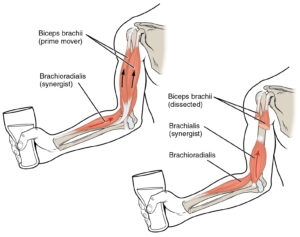
FIG. #2. Biceps Brachii in a partially flexed position.
(Brachioradialis, a “synergist,” also shown.)
IMAGE from: https://pressbooks.bccampus.ca/humanbiomechanics/wp-content/uploads/sites/972/2020/04/1101_Biceps_Muscle.jpg
And just to be a little more expansive in your understanding, and quoting from the Introduction to the eBook Human Biomechanics:
Before we go any further, let’s define ‘Biomechanics‘. You can separate the word into two parts: ‘Bio’ which suggests that Biomechanics involves living or biological systems, and ‘Mechanics’ which suggests the analysis of forces and their effects. Biomechanics is the study of structure and function of biological systems by the means of mechanics (Hatze, 1974). The goal of biomechanics related to human movement is to improve physical performance (through improved technique, equipment or training) and injury prevention and rehabilitation.
(The Schools of Advanced Bodywork teach you everything you need to know to perform our form of musculo-fascial therapy. But if you decide to pursue more in-depth info on the subject, this could be a good place to start.)
A TIP on Terminology …
By the way, in medical terminology, the “upper arm” is called “the ARM.” The forearm is called the, well, FOREARM. … That’s just in case you’re talking to someone who is well educated in medical terminology and you want to look and sound like a professional!
On the other hand, if you are mostly talking to Clients or other massage therapists, saying “upper arm” instead of “arm” won’t be a problem. But if you ever find yourself in a highly professional medical environment, using imprecise terminology is frowned upon, and you could lose credibility. So it pays to learn the terminology as best you can.
Basic or Simple vs. Complex Kinesiology
So in basic or simple kinesiology, there is the simple, one muscle, one bone interaction. Then there are the more complex kinesiological actions of multiple interactions between more than one muscle and bone. …
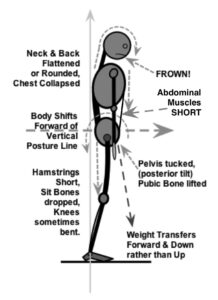
In a more complex example of “what is kinesiology,” say you want to understand which muscles are pulling a Client’s (or anyone’s) rib cage, chest and neck/head area down and forward. That is a classic slouching posture, like the unhappy guy in the illustration (FIG. #3) on the right …
Stemming from a collapsed rib cage, he has a classic forward head/neck posture, a slouch of the torso, and a possibly a “potbelly”! (And if you were looking from the front, he possibly has “love handles,” too!).
Too many therapists, and even many physicians, think forward head/neck is from something wrong in the neck. So they try to “fix the neck.” Yet while it is sometimes in the neck, many people have a forward head/neck from a collapsed rib cage, which is from over-shortened abdominal muscles.
Of course, a personal or fitness trainer, and many physical therapists (PTs), will say the muscles in the back and back of the neck are “too weak” to hold the head up. So they try to strengthen those muscles. Yet if the problem DOES originate in “too tight” and over-shortened abdominals, the trainer or PT will just make the problem worse.
As a well-trained Myo-Structural Bodyworker, you will use kinesiology to determine the difference and are more likely to use the correct treatment strategy.
Here is a more precise illustration of how shortened abdominal muscles cause postural imbalances …
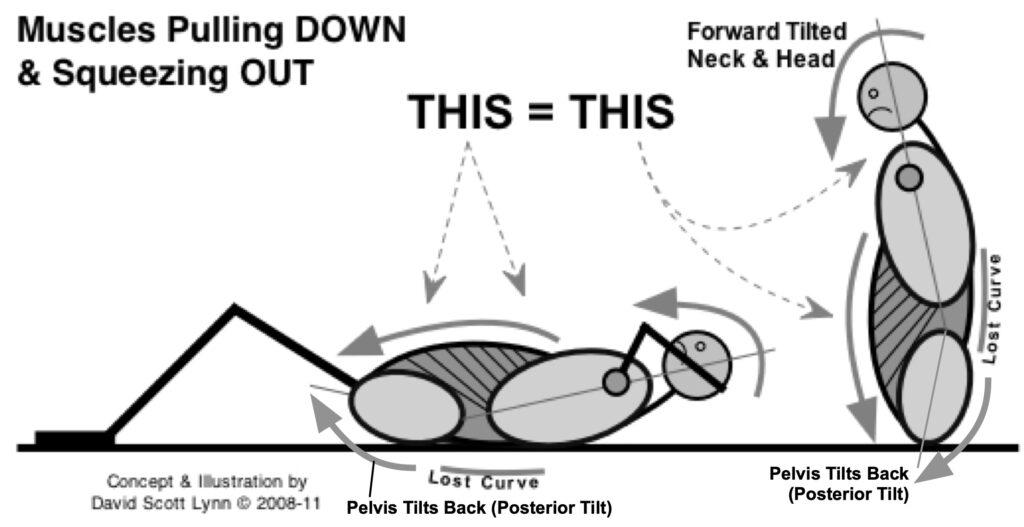
FIG. #4
Do Sit Ups & Crunches Cause
Slouched Posture & Back Troubles?
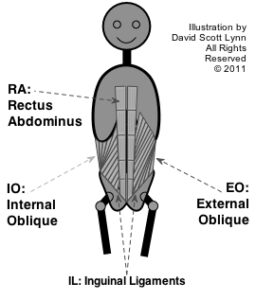
FIG. #5
Notice that those short abdominal muscles in FIG. #4 are the SAME muscles that activate to perform Sit Ups or Crunches!
So does that mean sit-ups might be a possible CAUSE of slouched posture? Or pot belly and love handles too? … Well, you might be able to see that for yourself from the above illustrations.
Digging a Little Deeper …
The kinesiological ACTIONS of the muscles pulling DOWN on the rib cage are produced in great part by the three pairs of muscles of the Abdominal Wall, listed below and illustrated to the right (FIG. #5) …
• Rectus Abdominus — RA
• External Oblique — EO
• Internal Oblique — IO
In the previous illustration above (FIG. #4 — Muscles Pulling Down & Squeezing …), the abdominal wall muscles are chronically contracted and in an over-shortened state, more or less permanently, if the Client does nothing resolve the problem.
To complicate things, the same muscles, when pulling DOWN on the rib cage, are ALSO pulling UP on the front of the pelvis, which tilts the top of the pelvis rearward (AKA, posterior tilt, SEE Fig. #s 3 & 4). Both actions — ribs coming down and pelvis tipping posteriorly — cause the lower back (lumbar region) to flatten, decreasing the curve of the lumbar (lower back) spine.
Sometimes, this becomes a REVERSE curve, which is REALLY troublesome. That is when the lumbar (lower back) vertebrae (spinal joints) are actually pushing out the back of the body!
Being part of the CORE of the body, all this can contribute to a wide range of issues in the low back and spinal discs. This postural imbalance can also have far-reaching effects in many other locations of the body up to the skull and down to the feet.
So you can start to see this can get much more complex than merely bending your elbow to pick up a glass of water, as in the illustration in Fig. #2. …
All of this is Functional Kinesiology.
You are observing the relationships between the bones and muscles, and also the functions of how the Client sits, stands and moves in space.
And if that bent-over person in above illustration #3 ever wants to stand up straight again, those three pairs of muscles — the Abdominal Wall — must ALL be relaxed & lengthened out again.
Not discussed here are the effects of the hip extensors ( the hamstrings [back of thighs] and gluteals [back & sides of hip muscles] ) on the slouched posture. Yet they are VERY involved in posterior tilts of the pelvis. And when the pelvis tilts posteriorly (tilts to the rear), in order to stay balanced in gravity, the pelvis pushes forward in space and the rib cage, neck, & head must move forward and down as well.
Then, everything in between gets compressed and dysfunctional.
“Abs of Iron …
Buns of Steel …
BACKS of PAIN!”“And Bad Posture, Too!”
Getting the body back to fully vertical & balanced requires those muscles to be more Relaxed or DE-contracted. And that is where your New Skills of Mindful Medical Massage come into play. And where You will become an EXPERT in providing all that to your Clients.
It might all look or sound complicated, but it is simple physics.
At the SAB, you’ll study Functional Kinesiology so you can more precisely evaluate which specific muscles are most responsible for a Client or Patient’s pain and/or dysfunction. This provides a more efficient & effective approach to tracking down soft tissue issues* many, if not most, therapists have trouble resolving. …
-
- Soft Tissues: For our purposes, the muscle cells, the fascia, the tendons & ligaments, and the nerves. The visceral organs and glands are soft tissues as well. We can and do have sometimes a profound effect on those, too, yet it is a little less direct.
So, Again, What Is Kinesiology?
For Our Purposes, Kinesiology is the Combination of …
• Structural Anatomy — Describing the size, shape, and characteristics of the muscles, fascial structures (including tensions and ligaments, and bones & joints.
• Functional Kinesiology — Describing what happens to bones & joints and soft tissues when a particular muscle contracts, or multiple muscles contract, moving the body.
• Neural Control Systems — The Brain, Central Nervous System, and Peripheral Nerves receive sensory data and send motor signals to muscles & organs.
• Physical Sciences — How external forces such as gravity act upon the body, as well as principles of leverage, structural shapes, hydrostatic (water) pressures in the body, and so on act upon and in the physical body.Your ability to utilize kinesiology also requires a great understanding and knowledge of Structural Anatomy. The SABs specialize in your learning Structural Anatomy & Functional Kinesiology to the extent necessary to be a Specialist in bringing a human body back to more normal alignment and more relaxed function, with greatly reduced tension and stress.
And in order to get those muscles to lengthen back out again, you will learn to apply Mindful Medical Massage to help your Clients Learn to FEEL, Relax, Lengthen & Balance the involved muscles.
That is the slow, steady, non-intrusive application of manual pressure (or stretching) — sometimes over much longer periods of time on specific muscles than most massage therapists work — to stimulate the nerve endings in the musculo-fascial units such that the central nervous system (CNS) and Brain “RESET” their neurological tension patterns back to a more normal state.
The more “normal state” is when musculo-fascial units are more fully relaxed and more able to function to their maximum capacities.
Now, just to expand your thinking on What Is Kinesiology, here is how the great Whitney Lowe of the Academy of Clinical Massage defines & describes kinesiology:
“Kinesiology is the exploration of human movement and integrates three disciplines: musculoskeletal anatomy (form), neuromuscular physiology (function), and biomechanics. Kinesiology is that area in which these three disciplines intersect. …
“Having a good foundation in these clinical sciences as they relate to soft-tissue treatment is a great starting point. By default, understanding kinesiological principles returns a better understanding of human structure and function.”~ https://www.academyofclinicalmassage.com/kinesiology-may-the-force-be-with-you/
The beauty, and one of the Great Advantages, of the Schools of Advanced Bodywork, is you do NOT have to go to a year or more of expensive, college-level courses to get a degree in kinesiology, to practice some form of Health- or Medical-focused Kinesiology.
You can, in 6 months, at far less cost, learn a high-level skill that includes anatomy & kinesiology, and you can begin helping people right after you graduate!
So Please go to (or back to) our School Home Page and learn more about the SABs and how your life will change by getting a solid education with us. Or if you want to know more about the Nuts & Bolts, go to the 500 Hour Curriculum page. …
And if you already have seen enough, head over to the School Catalog Request page, get a catalog, and give us a CALL at …
(904) 337-1602
The above-linked article is by
David Scott Lynn,
founder of DSL Edgework.
His therapy work is part of the SAB’s Core Curriculum
(SABs: Schools of Advanced Bodywork.)
- Thank You Very Much for Reading about What is Kinesiology Education included at the School of Advanced Bodywork in Jacksonville, Florida!
